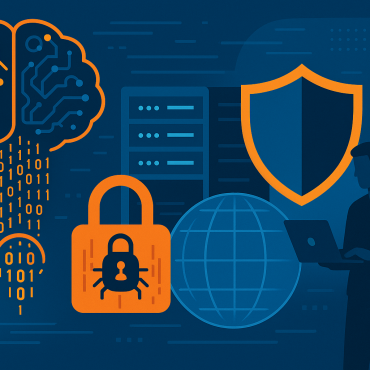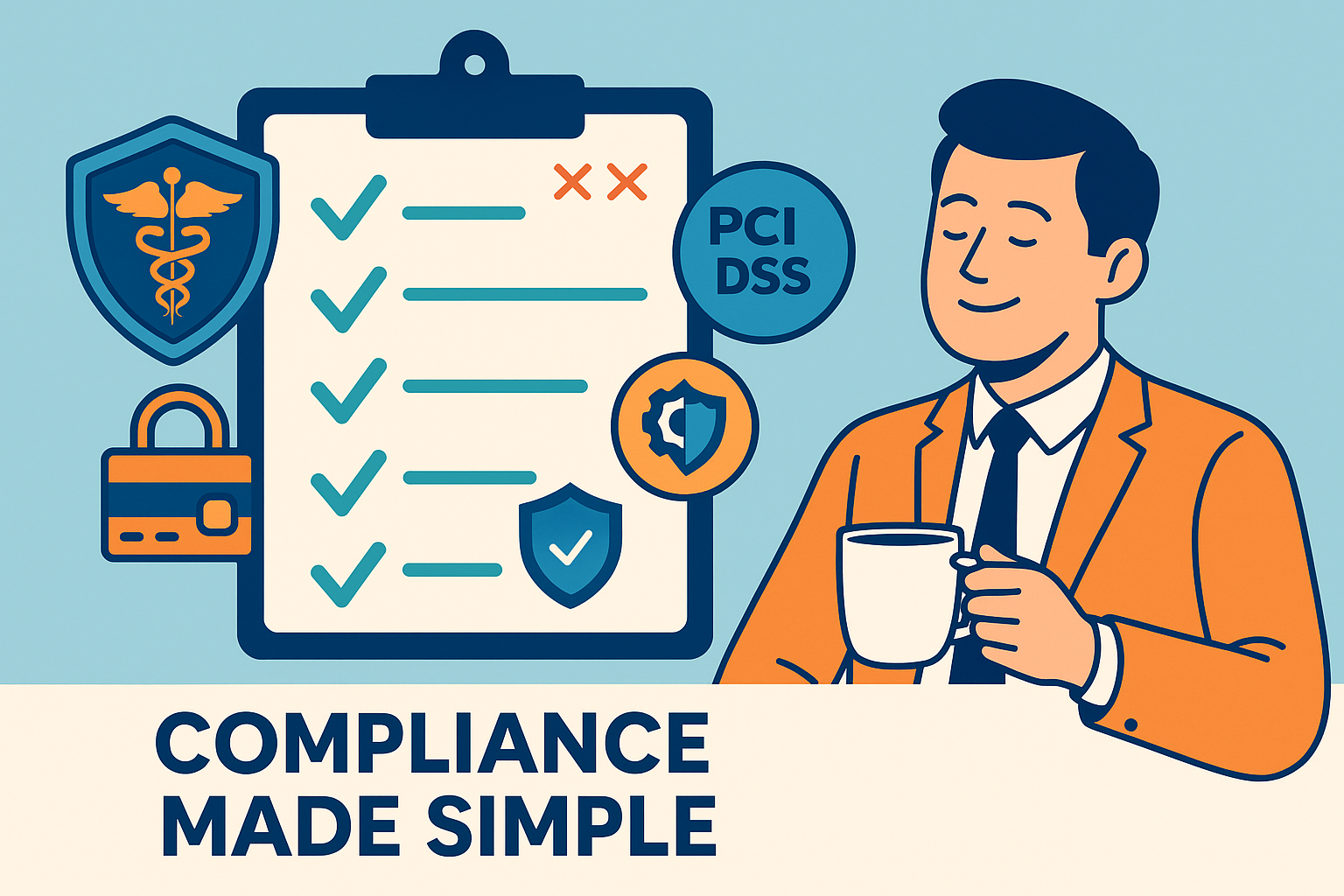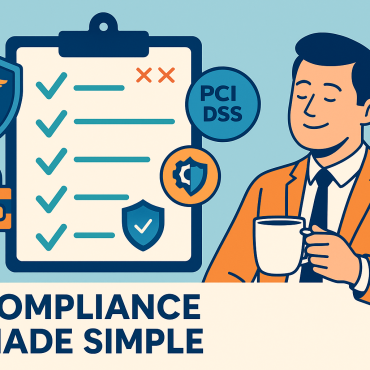Compliance Made Simple: HIPAA, PCI DSS, and SOC 2 Without the Headache
Regulatory compliance doesn’t have to be the business nightmare that keeps you awake at 3 AM. Whether you’re a healthcare provider handling patient data, a retailer processing credit card transactions, or a SaaS company managing sensitive client information, meeting compliance requirements can be straightforward, cost-effective, and even competitive advantage—when you know what you’re doing.
The stakes are real: HIPAA violations can result in fines up to $1.5 million per incident. PCI DSS non-compliance can cost businesses up to $500,000 in penalties. SOC 2 failures can destroy client trust overnight. But here’s what most businesses don’t realize—compliance isn’t just about avoiding fines. It’s about building a security foundation that protects your business and drives growth.
Understanding the Compliance Landscape: More Than Just Checkboxes
HIPAA Compliance: Protecting Healthcare Data
The Health Insurance Portability and Accountability Act (HIPAA) isn’t just for hospitals. If your business handles any protected health information (PHI)—from medical billing companies to employee wellness programs—HIPAA compliance is mandatory.
Key HIPAA Requirements:
- Administrative Safeguards: Policies, procedures, and workforce training for PHI protection
- Physical Safeguards: Controlling physical access to systems containing PHI
- Technical Safeguards: Encryption, access controls, and audit logging for electronic PHI
- Risk Assessment: Regular evaluation of potential vulnerabilities and threats
- Business Associate Agreements: Ensuring third-party vendors also maintain HIPAA compliance
Common HIPAA Compliance Mistakes:
- Unencrypted email communications containing PHI
- Inadequate employee training on privacy policies
- Lack of proper access controls and user authentication
- Missing audit trails for PHI access and modifications
- Insufficient incident response procedures for data breaches
PCI DSS Compliance: Securing Payment Card Data
The Payment Card Industry Data Security Standard (PCI DSS) applies to any organization that stores, processes, or transmits credit card information. This includes retailers, e-commerce sites, payment processors, and service providers.
The 12 PCI DSS Requirements:
- Install and maintain firewall configuration
- Don’t use vendor-supplied defaults for passwords
- Protect stored cardholder data with encryption
- Encrypt transmission of cardholder data across public networks
- Use and regularly update anti-virus software
- Develop and maintain secure systems and applications
- Restrict access to cardholder data by business need-to-know
- Assign unique ID to each person with computer access
- Restrict physical access to cardholder data
- Track and monitor all access to network resources
- Regularly test security systems and processes
- Maintain information security policy
PCI DSS Compliance Levels:
- Level 1: Over 6 million transactions annually (most stringent requirements)
- Level 2: 1-6 million transactions annually
- Level 3: 20,000-1 million e-commerce transactions annually
- Level 4: Under 20,000 e-commerce transactions annually
SOC 2 Compliance: Building Trust Through Transparency
Service Organization Control 2 (SOC 2) compliance demonstrates that your organization has proper internal controls for security, availability, processing integrity, confidentiality, and privacy. It’s becoming essential for B2B SaaS companies and service providers.
SOC 2 Trust Service Criteria:
- Security: Protection against unauthorized access
- Availability: System operational availability as committed
- Processing Integrity: System processing completeness and accuracy
- Confidentiality: Information designated as confidential is protected
- Privacy: Personal information collection, use, retention, and disposal
SOC 2 Type I vs. Type II:
- Type I: Point-in-time assessment of control design
- Type II: Assessment of control effectiveness over time (typically 3-12 months)
The Hidden Business Benefits of Compliance
Smart business leaders understand that compliance isn’t just about avoiding penalties—it’s about competitive advantage.
Enhanced Customer Trust and Market Access
B2B Sales Acceleration: SOC 2 compliance can reduce enterprise sales cycles by months. When prospects see you’re already compliant, security questionnaires become formalities rather than deal-breakers.
Insurance Premium Reductions: Many cyber liability insurance providers offer significant premium discounts for compliant organizations. The savings often offset compliance costs entirely.
Regulatory Audit Readiness: Continuous compliance monitoring means you’re always audit-ready, eliminating the stress and cost of scrambling to prepare for regulatory reviews.
Operational Efficiency and Risk Reduction
Streamlined Security Operations: Compliance frameworks provide structured approaches to security that eliminate ad-hoc, reactive security measures.
Reduced Data Breach Risk: Compliant organizations experience 40% fewer security incidents on average, according to industry studies.
Improved Incident Response: Compliance requirements for incident response planning and testing ensure you’re prepared when threats materialize.
Common Compliance Pitfalls (And How to Avoid Them)
The “Set It and Forget It” Mistake
The Problem: Many organizations treat compliance as a one-time project rather than an ongoing process.
The Solution: Implement continuous monitoring and regular compliance assessments. Compliance is a journey, not a destination.
Inadequate Documentation
The Problem: Poor documentation makes it impossible to demonstrate compliance during audits.
The Solution: Maintain comprehensive, up-to-date documentation of all policies, procedures, and security controls. Automated documentation tools can streamline this process.
Scope Creep and Over-Compliance
The Problem: Organizations often apply compliance requirements too broadly, increasing costs and complexity unnecessarily.
The Solution: Clearly define compliance scope and apply requirements only where legally required. Focus resources on protecting truly sensitive data.
Vendor Management Gaps
The Problem: Third-party vendors can create compliance vulnerabilities if not properly managed.
The Solution: Implement comprehensive vendor risk management programs with regular assessments and contractual compliance requirements.
The FortiShield Compliance Advantage: Automated, Continuous, Stress-Free
At FortiShield Tech Group, we’ve transformed compliance from a burden into a business enabler. Our approach eliminates the traditional pain points while ensuring you’re always audit-ready.
Automated Compliance Monitoring
Real-Time Compliance Dashboards: Our systems continuously monitor your compliance posture across all relevant frameworks, providing real-time visibility into your status.
Automated Evidence Collection: Instead of scrambling to gather evidence during audits, our systems automatically collect and organize the documentation auditors need.
Gap Analysis and Remediation: When compliance gaps are identified, our system provides specific remediation guidance and tracks progress to closure.
Framework-Specific Expertise
HIPAA Compliance Program:
- Comprehensive risk assessments and gap analysis
- Policy and procedure development
- Employee training and awareness programs
- Technical safeguards implementation and monitoring
- Business associate agreement management
- Incident response planning and testing
PCI DSS Compliance Program:
- Cardholder data environment assessment and segmentation
- Vulnerability scanning and penetration testing
- Security policy development and implementation
- Quarterly compliance validation and reporting
- Remediation guidance for failed requirements
SOC 2 Compliance Program:
- Control design and implementation
- Evidence collection and documentation
- Continuous monitoring and testing
- Audit preparation and support
- Type I and Type II readiness assessment
Integrated Security and Compliance
Unlike traditional compliance consultants who focus only on paperwork, FortiShield integrates compliance requirements into your overall security program. This approach ensures that compliance controls actually improve your security posture rather than just checking boxes.
Technical Control Implementation:
- Encryption for data at rest and in transit
- Access control and identity management
- Network segmentation and monitoring
- Vulnerability management and patch deployment
- Incident detection and response automation
Operational Control Management:
- Policy development and maintenance
- Employee training and awareness
- Vendor risk management
- Change management processes
- Audit and compliance reporting
Compliance ROI: The Numbers Don’t Lie
Our clients see measurable returns on their compliance investments:
Reduced Insurance Premiums: Average 25% reduction in cyber liability insurance costs
Faster Sales Cycles: B2B clients report 30-50% reduction in enterprise sales cycle length
Audit Efficiency: 75% reduction in time and resources required for compliance audits
Incident Cost Avoidance: Compliant organizations experience 40% fewer security incidents
Regulatory Fine Avoidance: Zero compliance-related fines among FortiShield clients
Your Compliance Readiness Assessment
Evaluate your current compliance posture with these critical questions:
HIPAA Readiness:
□ Do you have current risk assessments for all systems handling PHI?
□ Are all employees trained on HIPAA privacy and security requirements?
□ Do you have business associate agreements with all relevant vendors?
□ Is PHI encrypted both at rest and in transit?
PCI DSS Readiness:
□ Do you know your current PCI DSS compliance level?
□ Are cardholder data environments properly segmented?
□ Do you have quarterly vulnerability scans and annual penetration tests?
□ Are all systems with access to cardholder data regularly updated and patched?
SOC 2 Readiness:
□ Have you defined which trust service criteria apply to your organization?
□ Do you have documented security policies and procedures?
□ Are security controls regularly tested and monitored?
□ Do you have evidence collection processes for audit preparation?
If you answered “no” or “I’m not sure” to any of these questions, you have compliance gaps that need immediate attention.
Making Compliance Your Competitive Advantage
The businesses that thrive in today’s regulatory environment are those that view compliance as a strategic advantage rather than a necessary evil. When done right, compliance programs:
- Accelerate sales by eliminating security concerns
- Reduce operational risk through structured security controls
- Lower insurance costs through demonstrated risk management
- Improve customer trust through transparent security practices
- Enable market expansion by meeting regulatory requirements for new sectors
Start Your Compliance Journey Today
Don’t let regulatory requirements hold your business back. With the right approach, compliance becomes a growth enabler rather than a growth inhibitor.
Ready to transform compliance from burden to advantage?
FortiShield Tech Group has helped businesses across healthcare, finance, retail, and technology achieve and maintain compliance with HIPAA, PCI DSS, SOC 2, and other regulatory frameworks. Our integrated approach combines technical controls, operational processes, and continuous monitoring to ensure you’re always audit-ready.
Get your free compliance assessment:
Compliance Hotline: (239) 427-4684
Assessment Request: GoForti.com
Direct Contact: Hello@GoForti.com
Don’t wait for a compliance audit or regulatory investigation to discover gaps in your program. Contact FortiShield Tech Group today and discover how proper compliance can become your competitive advantage.
About FortiShield Tech Group
FortiShield Tech Group provides comprehensive cybersecurity and compliance solutions for businesses across the continental United States. With headquarters in Southwest Florida and coast-to-coast capabilities, we specialize in making complex regulatory requirements simple and manageable. Our team holds certifications in CompTIA CySA+, PenTest+, Security+, and other industry standards, ensuring expert guidance for your compliance journey.
Related Services: 24/7 SOC Monitoring | Penetration Testing | Vulnerability Assessments | Employee Security Training | Incident Response | Backup and Disaster Recovery








Post comments (0)